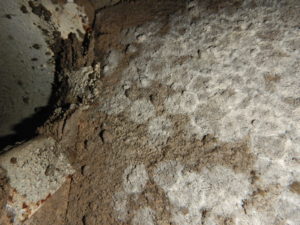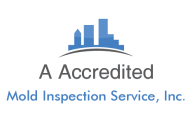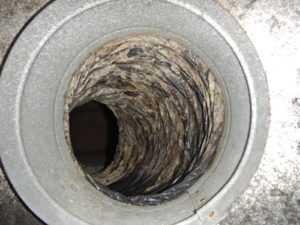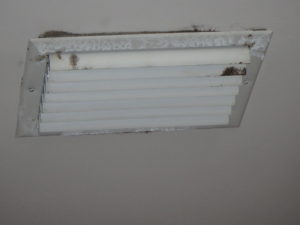Information for Mold Inspectors on How to Inspect AC Ducts?
It is important for mold inspectors to know how to inspect AC ducts. AC duct inspections are without a doubt one of the most important type of mold investigation to be conducted. However, AC duct and AC unit inspections for mold should only be done by fully licensed and trained professionals. Also read the disclaimers at the bottom of this article.
Unfortunately, many inspectors do not inspect AC ducts and AC systems in any detail.
Stick with the Basics.
When conducting an AC duct inspection for mold it is important to know how to do it properly. Start with the most basic and most common-sense approach. On most systems you will start by opening the louvered slats on the register and use a strong flashlight and simply look into the ends of the ducts through the registers.
What Does AC Duct Mold Look Like?
When mold inspectors check AC ducts, they should look for mold, dust, and other dirty debris in the duct.
A Guide to What You May Be Seeing:
Inside ducts mold is often grey, white, or black. This growth is almost always Cladosporium mold, it may have some Pen Asp mold mixed in.
That fuzzy grey stuff that looks like velvet on the bottom of many evaporator coils and inside supply plenums is also typically Cladosporium mold.
The black stuff inside AC units and ducts is also typically Cladosporium mold.
Black patches on registers are also often Cladosporium mold.
The clear or white slimy or jelly like substance on the bottom of coils and inside the condensation pan is bacillus (rod shaped) bacteria. This slimy or jelly like bacterial bio film and also rust will sometimes clog condensation drain lines and cause the pan to overflow.
I know this stuff is bacteria and Cladosporium because I have sampled the materials inside AC units hundreds of times.
To Remove or Not to Remove Registers.
If you cannot get a good view of the interior of the duct with the register on, then it may be beneficial to remove the register. Only remove register covers if you are certain you will be able to re-install them. When inspecting AC ducts if you remove the register covers you will find removal easy. It can sometimes be very difficult to re-install and screw the registers back on. This is because aligning the screw with the screw holes is harder on AC registers than on other items around the home.
If you have an 18-volt battery operated drill with screw driver bits then re-installing the register can be easier. Your drill and the registers sharp screws can be used to make new screw holes if the screw does not line up properly with the original screw hole.
Mold Inspectors Should Not Forget to Inspect the Bottom of Ducts
When inspecting ducts, it is very important to note that the top and side walls of the duct interiors may appear satisfactory. The bottom or floor of the same exact duct interior may be severely contaminated with mold and dust. The reason is obvious, when the blower fan shuts down air stops flowing through the ducts. Gravity takes over and condensation and dust settles out on the bottom of the duct interior. This results in the top and side walls of the duct’s interior being much cleaner. When viewing a duct while standing on the floor the bottom of a dirty duct may not be visible. Standing on even a small ladder can often make contamination on the bottom of the duct more accessible for viewing.

Extremely moldy duct interior. Note the tannish grey and white Cladosporium mold as discusses in our article.
Duct Mold Look-a-Likes
Most of the time, most of the stuff inside ducts is mold, at least in my area. Sometimes it may be household dust, this is especially true if it is grey and resembles loose fine, dry grey household dust.
In very rare cases if a home has undergoing renovations in past days or years, you may find a fine powdery white dust in the ducts. This fine white dust is typically floor tile or drywall dust. I have seen this only a very few times. When construction workers cut drywall or tile indoors it creates massive amounts of fine white dust that becomes lodged in the ducts. However, this is rare because most workers take precautions to cut down on indoor dust production.
What About Borescopes
I sometimes use a digital borescope with a flexible fiber optic cable to aid in the visual inspection of AC ducts. At times a borescope can aid in such investigations. Even the bottom of the duct becomes visible when using a borescope. Such devices can be a useful tool for mold inspectors, but they have limitations. One limitation of borescopes is that the size and color of contamination in any location inspected with a borescope is distorted. With or without a borescope you can only see so far into a duct. If the duct makes a sudden 90 turn, then you will not be able to see beyond that turn. Though borescopes can be an aid, when possible, a visual inspection with the un aided eye is often better.
Opening Ducts
If there is an attic space with accessible ducts it can be beneficial to enter the attic and cut open the supply plenum duct for internal inspection. This provides a perfect opportunity to inspect and photograph the interior of the plenum duct for your clients. When opening a duct sampling is easy, but even if you do not open a duct a swab can make sampling through registers easy. You must make sure to never open any ducts unless you are ready and equipped to properly and thoroughly seal each and every duct section after inspection. The above methods are to only be done by qualified professionals who know how to move around in attics and how to work with AC ducts.
Inspecting Duct Endpoints for Mold
Fortunately for mold inspectors, the last few feet of any duct just behind the register is not only the most accessible duct section for inspection, it is also often the most contaminated section of many ducts. Why the ends of the ducts? Warm humid indoor air rises up into the ducts from kitchens, bathrooms, and other humid areas. This moisture condenses in the end of the cold duct before it travels further than a few feet. I have seen this many times while conducting mold inspections. If a duct has only some sections that are contaminate you are more likely going to find that contamination in the more accessible end section of the duct within about 18 inches of the register. Not always true but sometimes it happens this way and benefits inspectors checking ducts for mold.
Inspecting the Supply Plenum
The one duct section more prone to mold problems than the bottom or floor of the ducts, and the last 18 inches of ducts is the supply plenum. Thus, it is very importing when you inspect AC ducts to inspect the large main supply plenum duct coming out of the AC.
This main or supply plenum is the massive typically square duct that attaches directly to the AC. The supply plenum brings cold air from the AC to the rest of the ducts. The supply plenum is where mold is often heaviest because it is full of cold air and cold air forms condensation. It is often made of fiberglass duct board, as a result, it is very easy to cut open. Home Depot sells a knife made especially for cutting open fiberglass plenums. Bring foil tape to re-seal the plenum after cutting it open. On rare occasions it may be necessary to clean the duct with soap and water for the tape to stick to the duct. Also bring mastic to seal the duct if it is one that will not accept sticky foil tapes adhesives.
If you are not inspecting the interior of supply plenums then you are missing an enormous amount of mold and doing your clients a great disservice.
Inspecting the Return Plenum
The return plenum is another important area to inspect, often returns are below AC units, thus water from the inevitable condensation pan leak ends up inside and around the return plenum. Often mold will grow un-noticed for months or years inside the return plenum after the condensation pan overflows. Even in the absence of any leaks this area is prone to becoming contaminated with heavy amounts of dust if the filter is missing or does not fit properly. It goes without saying that return plenums are very often quite moldy.
When Mold Inspectors Check AC Ducts They Should Trust Their Nose
When checking ducts, the mold inspector should check for mold odor coming out of the ducts. Make sure the AC is on and smell for mold. I have found to trust my nose more than expensive high-tech tests for mold odors. Another name for mold odors in microbial volatile organic compounds or MVOC’s.
If you can smell mold odors with your nose, then in my opinion it is a problem. Your nose can often pick up problems that our eyes cannot see. If you can smell mold odor from the ducts then it may not be necessary to inspect further because you know the AC and the ducts will have to be cleaned professionally.
The lack of mold odor does not mean the residue in a duct is not mold.
Mold in ducts does not always give off an odor. Sometimes the mold is dormant and not very actively consuming moisture and food. If it’s dormant, then mold may not produce many odorous waste products.
The scientific term for these odors is microbial volatile organic compounds. Prism Analytical sells pumps and thermal desorption sample tubes that can be used to test for microbial volatile organic compounds. They can also be used to test for your more typical volatile organic compounds. Prism Analytical is a great lab, they will also do the analysis of the samples.
Remember the AC Coils
I know this is supposed to be an article on inspecting moldy ducts. As we all known the interior of the air handler is a good place to inspect as well. The bottom side of AC coils catch dust when the filter fails to do its job. Also, AC coils condense moisture from the air, and as a result, they are wet when working properly. Wet dusty surfaces like coils are prone to growing mold and bacteria eventually. As a result, the bottom side of coils are very often contaminated with mold or bacterial growth, and as a result, are an extremely important area to check on your inspections.
Important Safety Disclaimers
ABOUT UV LIGHTS and AC INSPECTION SAFETY
Before we discuss how to inspect AC ducts, please be aware of some dangers. UV lights are common in AC units and plenum ducts. They consist of a clear light bulb installed in the system and are dark blue when turned on. They can damage your eyes. If a UV light is installed anywhere inside the AC unit or ducts turn it off before opening the AC unit. They are usually inside the AC plenum, or under the coils. These lights do a great job of preventing mold and bacteria growth inside AC units and ducts, but they can damage your eyes if you look at them.
EYE PROTECTION AND DEBRIS
In some areas it may be required for you to be an AC contractor or licenses AC serviceperson to open AC units. Another warning is that the chances are extremely high that if you inspect ducts, fiberglass insulation, mold, dust, or some other debris will fall in your eyes. You are hereby warned that you must be careful, and also wear protective eyewear when removing registers and inspecting ducts. Finally, do not inspect ducts if you have allergies or asthma to mold. An asthma attack can send you to the hospital.
ELECTRICAL HAZARDS
AC units contain exposed electrical wires, they also contain a capacitor that stores large amounts of dangerous electricity even when the AC has been turned off. Touching such components can cause a dangerous or even deadly shock. AC dust are fragile and can be easily damaged. For these reasons and more, inspecting AC units and ducts is best performed by a professional mold inspector or AC contractor.
WHO SHOULD USE THIS INFORMATION?
If you are not a professional mold inspectors or AC service person and you suspect a mold problem inside your AC system or ducts, you should have the system inspected by a licensed and trained mold inspector. This duct inspection information is intended to be used by qualified mold inspectors.
Some More Related Resources on This Website.
I have a few pictures of Cladosporium mold on register and in ducts on this page. Here I discusses Cladosporium mold and also moldy ducts. I even have information on, and images of, this same type of mold growing in it’s other chosen environments outdoors.
About the Author
Daryl Watters is a licensed mold inspector with An Accredited Mold Inspection Service, Inc. He has 54 hours of air conditions I and 54 hours of air conditions II courses under his belt. In addition, he has written extensively on the inspection of mold in AC units, ducts, and homes. He has performed mold inspections since 2003.


